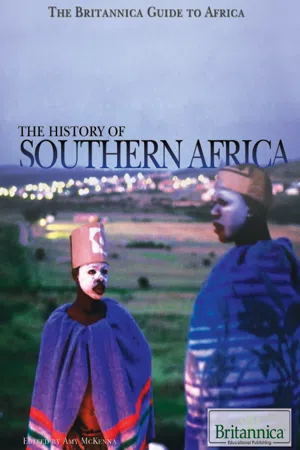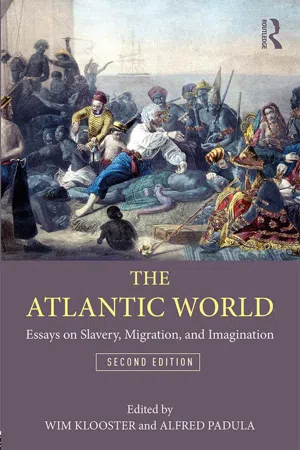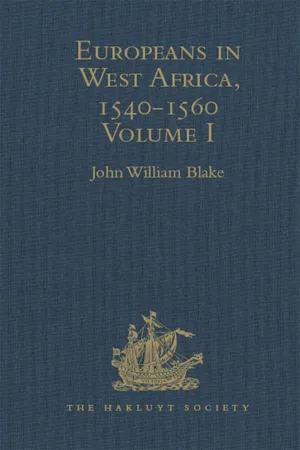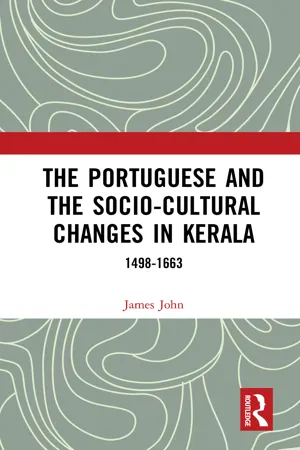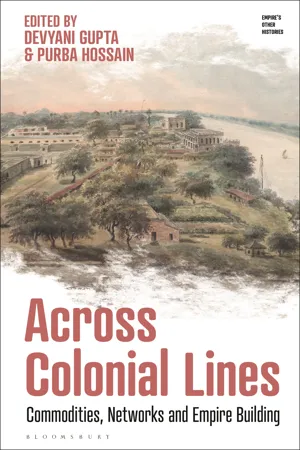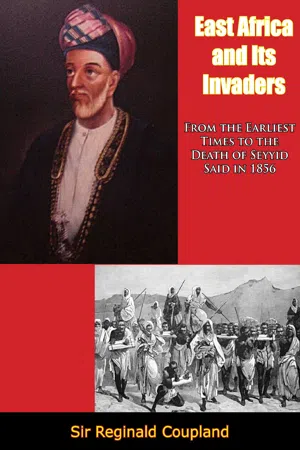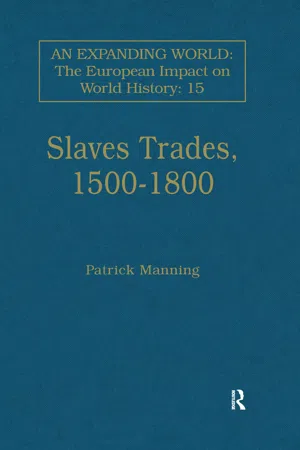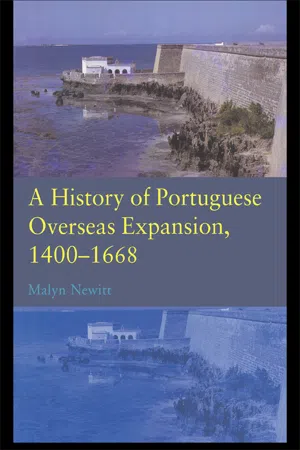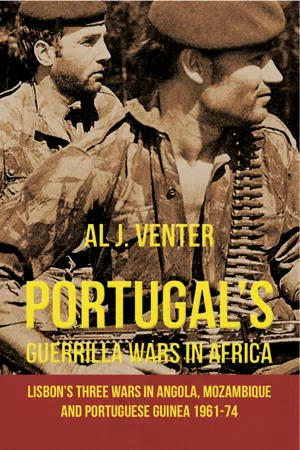History
Portuguese Exploration of Africa
The Portuguese exploration of Africa refers to the period from the 15th to 17th centuries when Portugal established trade routes and colonies along the African coast. Led by explorers such as Vasco da Gama and Bartolomeu Dias, the Portuguese sought to find new trade routes to Asia and expand their empire. This exploration had a significant impact on the history of Africa and global trade.
Written by Perlego with AI-assistance
Related key terms
12 Key excerpts on "Portuguese Exploration of Africa"
- eBook - ePub
The Roots and Consequences of Independence Wars
Conflicts That Changed World History
- Spencer C. Tucker(Author)
- 2018(Publication Date)
- ABC-CLIO(Publisher)
Portuguese explorers initiated the European Age of Discovery in the 15th century. The Portuguese Crown sent ships to locate sources of gold on the eastern coast of North Africa. They also sought to discover a sea route to Asia for the lucrative spice trade. As early as 1418–1419 Portuguese sailors undertook explorations of the African coast and the Atlantic archipelagos. In 1488 Bartolomeu Dias rounded the southern coast of the African continent into the Pacific, and in 1498 Vasco da Gama reached India. In 1500 Pedro Álvares Cabral made landfall on the southeastern coast of South America in what would be Brazil. By the 16th century, its empire was accounting for perhaps 20 percent of the Portuguese economy.In 1580 King Philip II of Spain (r. 1556–1598) inherited the Portuguese throne as King Philip I of Portugal. During the 60 years that Portugal and Spain were united, the Portuguese Empire came under attack from three major seafaring countries at war with Spain: England, France, and the Dutch Republic. With its small population, Portugal proved unable to defend its empire, which now began a slow but steady decline. Brazil broke away in 1822 as a consequence of the Napoleonic Wars and the Wars of Latin American Independence.During the late 1800s there was a great scramble by the major European powers for territorial holdings in Africa. The goals here were largely economic gain, naval bases, and international prestige. During this period the European colonial powers expanded their coastal holdings deep into the African interior. After World War I nationalism impacted the African colonies. U.S. president Woodrow Wilson’s declaration of self-determination of peoples resonated in Africa and in Asia, even though Wilson was applying it only to Europe.The Portuguese Colonial Act of June 13, 1933, recognized the supremacy of the Portuguese over all native peoples. Although blacks could pursue higher education, they were left at great disadvantage in their own land. - eBook - ePub
The First World Empire
Portugal, War and Military Revolution
- Hélder Carvalhal, André Murteira, Roger Lee de Jesus, Hélder Carvalhal, André Murteira, Roger Lee de Jesus(Authors)
- 2021(Publication Date)
- Routledge(Publisher)
15 The extreme focus of international military historiography on the Spanish, English, and Dutch empires in the Americas and South East Asia, therefore, make the Portuguese Empire and its expansion in Africa a valuable addition to explore in the global impact that the Military Revolution had. It presents an interesting exercise to assess the extent to which the technological breakthroughs recorded in Europe gave the Portuguese a concrete military edge over West Central African polities before the Industrial Revolution.The Portuguese in Atlantic Africa
The Portuguese “overseas expansion” began with the conquest and occupation of the Moroccan city of Ceuta in 1415. Motivated by the search for better supplies of gold from trans-Saharan trade routes, among other economic (and political) factors, the Portuguese directed several voyages of exploration along the Atlantic Coast of Africa during the fifteenth century.16 While trade was the main purpose of the Portuguese when dealing with powerful sub-Saharan polities (such as the Jolof or the Mali Empire), early expeditions would sometimes result in violent encounters against smaller villages on the coast of Senegal, and its inhabitants were taken captive and sold in Portugal as slaves. Plundering expeditions in Senegambia were short-lived, however: not only were the Portuguese unable to establish an actual foothold and venture far inland, but the resistance and organization of local African communities on West African shores proved to be major obstacles as well. Those populations rapidly organized themselves to fight against foreign threats on land and at times even managed to repel the Portuguese ships from their shores.17 Gomes Eanes de Zurara, the official chronicler of the court of Portuguese King Afonso V (1438–81), retells the expedition led by Rodrigo Annes and Diogo Dinis to the isle of Gorée around 1445 and reports their failed attempt at capturing slaves, a failure that was due to its inhabitants being “not easy to enslave” because they were “strong foes, competent in battle who use arrows bathed with a dangerous herb [poison].”18 The local populations along the Senegambia and Upper Guinea also used small vessels to outmanoeuvre the large ships of the Portuguese, and these populations drove the Portuguese away by using poisoned arrows, which rendered the armour of the Portuguese useless. The massacres at the hands of the raiders from the Gorée or the Bissagos Islands, were but a few of the episodes which forced the small Portuguese exploratory crews to abandon their military ambitions and instead focus on establishing peaceful and commercial relations with the authorities on the coast.19 - eBook - ePub
- Britannica Educational Publishing, Amy McKenna(Authors)
- 2010(Publication Date)
- Britannica Educational Publishing(Publisher)
UROPEAN AND AFRICAN INTERACTIONT he first Europeans to enter Southern Africa were the Portuguese, who from the 15th century edged their way around the African coast in the hope of outflanking Islam, finding a sea route to the riches of India, and discovering additional sources of food. They reached the Kongo kingdom in northwestern Angola in 1482–83. Early in 1488, Bartolomeu Dias rounded the southern tip of the continent, and just over a decade later, Vasco da Gama sailed along the east coast of Africa before striking out to India. Although the voyages were initially unpromising, they marked the beginning of the integration of the subcontinent into the new world economy and the dominance of Europeans over the indigenous inhabitants.THE PORTUGUESE IN WEST-CENTRAL AND SOUTHWESTERN AFRICA
Portuguese influence in west-central Africa radiated over a far wider area and was much more dramatic and destructive than on the east coast. Initially the Portuguese crown and Jesuit missionaries forged peaceful links with the kingdom of the Kongo, converting its king to Christianity. Almost immediately, however, slave traders followed in the wake of priests and teachers, and west-central Africa became tied to the demands of the São Tomé sugar planters and the transatlantic slave trade.Principal peoples of Southern Africa, 17th to mid-19th century .Until 1560 the Kongo kings had an effective monopoly in west-central Africa over trade with metropolitan Portugal, which showed relatively little interest in its African possessions. By the 1520s, however, Afro-Portuguese traders and landowners from São Tomé were intervening in the affairs of the Ndongo kingdom to the south, supporting the ruler, or ngola - eBook - ePub
The Atlantic World
Essays on Slavery, Migration, and Imagination
- Willem Klooster, Alfred Padula, Willem Klooster, Alfred Padula(Authors)
- 2018(Publication Date)
- Routledge(Publisher)
Why should we think of the Portuguese experience in the early modern Atlantic world as a historical paradox? Given the circumstances surrounding the establishment of the Portuguese seaborne empire, and Lisbon’s position in it, in what ways did reality contradict reasonable expectation? Simply stated, given its relative size and power, Portugal was nonetheless able to organize the world’s first global maritime commercial and colonial empire, a considerable part of which was on the opposite side of the planet. In an age of wind-powered ships and primitive navigation, such an achievement is paradoxical.Portugal in the fifteenth and sixteenth centuries was small in population and resources. Around 1450, Portuguese territories were home to just over one million people—a tiny population on which to base a global expansion.9 Lisbon had approximately 60,000 inhabitants; 200 years later it had perhaps 150,000. In comparison with other larger European states, the monarchy was not wealthy; per-capita agricultural output was low. Despite these limiting factors, the Portuguese developed their maritime capabilities to such a high state that, beginning in 1415, they could support global expansion and exploration, something no other European kingdom would undertake for generations. The Portuguese were the first Europeans to systematically explore the West African coastline and people the offshore islands they discovered: Madeira, the Azores, and the Cape Verde Islands. By the end of the fifteenth century, they had pushed their explorations around the Cape of Good Hope and on to western India.Portugal became the first modern European nation-state to establish maritime colonies outside of Europe, thanks to the ruthless application of superior seaborne technology—artillery mounted aboard strongly built ships. Portugal developed a complex network of rich maritime enclaves on three continents beyond Europe. By the first quarter of the sixteenth century, far-flung Portuguese holdings in all the world’s oceans possessed colonial administrations—some entrenched and some precarious—that looked to Lisbon for law, protection, and a cultural standard set in the Iberian metropole. The Portuguese established imperial bases in Morocco, Madeira, the Azores, Guinea, São Tomé, Princípe, Cape Verde, Brazil, Angola, Mozambique, Zanzibar, Mombasa, Hormuz, Diu, Damão, Bassein, Goa, Cochin, Ceylon, Malacca, Timor, Tidore, Ternate, the Banda Islands, Macau, and Nagasaki. Taken together, these territories represent such an enormous geographical area that holding them together as a coherent, viable overseas empire required a mastery of navigation and logistical strategy. - No longer available |Learn more
Europeans in West Africa, 1540-1560
Documents to illustrate the nature and scope of Portuguese enterprise in West Africa, the abortive attempt of Castilians to create an empire there, and the early English voyages to Barbary and Guinea
- John William Blake(Author)
- 2017(Publication Date)
- Hakluyt Society(Publisher)
SECTION ITHE FIRST CENTURY OF PORTUGUESE ENTERPRISE IN WEST AFRICAPassage contains an image SECTION I INTRODUCTION
T HE history of the first century of the Portuguese discovery and occupation of the West African coast may be conveniently divided into three periods: firstly, that of exploration up to 1480; secondly, the very prosperous period of trade and settlement from 1481 to 1530; and, thirdly, the period of gradual decline after 1530, a decline which resulted from the intrusion of interlopers and the consequent destruction of settlements and the interruption of trade. The history of the first period has always attracted close attention from scholars, the second some, and the third scarcely any attention, and one of the reasons for this is that contemporary records for the fifteenth century are, or have been made, more readily available for the general reader than those for the sixteenth century. The reader may obtain a more coherent and balanced account of the course of events from the documents printed below. These have been preceded by a review of what is known about the exploration of the Guinea coast between 1462 and 1480, and a description of West Africa under the Portuguese between 1481 and 1560.The Discovery of the West African Coast, 1462–80Much has been written about Portuguese oversea exploration before 1480. Its progress onwards from the conquest of Ceuta in 1415 was recorded in the reign of King Affonso V by a few notable contemporaries, many of whose works have been happily preserved, and since then a great number of historians have tried to reconstruct the story. Of the extant contemporary accounts, Azurara’s Chronicle of the discovery and conquest of Guinea provides the most complete and most authentic record of exploration down the West African coast approximately up to the year 1448, while the narratives of the voyages of Cadamosto, Diogo Gomes and Pero de Cintra carry the story onwards to 14621 . Exploration during the years from 1462 to 1480, however, has not been chronicled with the same degree of detail and precision. During this period the Portuguese explored the Mina (or Gold) coast, the larger islands in the Gulf of Guinea, and probably also the curving and indented coast of the African mainland around the Gulf as far south as Cape St. Catherine. Yet there is extremely little contemporary evidence of this great advance. The best account may be found in chapter two of the second book of the first decade of the Asia, published by João de Barros in 15522 . Barros produced his history long after the event, but there are solid reasons for accepting his narrative as fairly reliable. He records that Pero de Cintra had already explored as far south as Sierra Leone. He proceeds to describe how in November 1469 King Affonso V leased the Guinea trade for five years to a Lisbon citizen named Fernão Gomes, on condition inter alia - eBook - ePub
- James John(Author)
- 2020(Publication Date)
- Routledge(Publisher)
3Figure 1: Map of Portugal in the fifteenth and sixteenth centuries, prepared by the author on the basis of information provided in H.V. Livermore, A New History of Portugal, London, 1969, pp. 3, 338.The Age of Discoveries
The Portuguese attempts to explore the African coast were dominated by three factors. First, Portugal needed slaves for tilling the lands of southern Portugal vacated by the Moors. Second, the Portuguese had a greed for gold, which was said to be in abundance in Africa. And finally, the Portuguese had a craving for pepper and other spices for food, which was becoming a mania in Europe.4Amidst the series of successes in the Iberian Peninsula and Africa, the capture of Constantinople by the Turks was a terrible shock to Christendom.5 It had its economic consequences for Europe. The profitable spice trade between the Orient and the Occident fell into the hands of the Turks who pocketed large amounts of profits. The Christian West had to depend upon the Moorish or Turkish merchants heavily for the spices of the East, which were in high demand in Europe. Thus the Muslim middlemen had drained much wealth from Europe.Against this backdrop, enmity to the Moors, Christening spirit of the Portuguese and the need for a new maritime trade route for trade in spices between the East and the West were the driving force behind the maritime activities of the Portuguese. Thus the series of expeditions and explorations became an affair of national interest.6Pope Alexander VI had assigned to Spain all lands south and west of a North-South line drawn in Atlantic between Azores and the Cape Verde Islands in 1493. The Portuguese got the Eastern hemisphere for their further exploration.7 Through the Treaty of Tordesilhas of 1494 between Portugal and Spain, the Portuguese succeeded in getting the line of demarcation, given by the Pope move 370 leagues to the West.8 Thus Brazil fell under the Portuguese sphere.9 - eBook - ePub
Across Colonial Lines
Commodities, Networks and Empire Building
- Devyani Gupta, Purba Hossain(Authors)
- 2023(Publication Date)
- Bloomsbury Academic(Publisher)
Here, engagement in diverse trades brought a cornucopia of produce into the Portuguese remit – most famously pepper – and required a careful management of trade to ensure that the demands of new trading partners across the region could be met. 39 Extensive Portuguese colonization in Brazil soon followed, especially after the founding of Olinda in 1536, where extractive plantation economies were established, often dependent on enslaved labour sourced via Portuguese activities in other parts of Africa. 40 Together, these imperial acquisitions meant that by the middle of the sixteenth century, the rich gold deposits accessed through trade with the Akan on the Costa da Mina, despite their very considerable returns, were increasingly understood not as a single point of trade, but as one node within a Portuguese imperial network. 41 As Subrahmanyam has noted in reference to Portugal’s Asian empire, by the mid-sixteenth century there were considerable debates about whether or not the Crown should maintain its prominent role in organizing (and paying for) the maritime empire. After 1570, corresponding with the period in which the reports about the Costa da Mina discussed below were written, shifting policies contributed to a ‘reorientation’ during which Portuguese actors showed ‘a far greater predilection for territorial adventurism than in any earlier period’. 42 This reorientation towards colonial activity contributed towards a ‘gradual retreat from Asia’, that ‘following the initial expansion and the ensuing repositioning to Brazil, changed Portugal’s colonial vocation, from trade and navigation to tropical slave plantations and mineral extraction. It also increased relative gains from overseas activity significantly’. 43 These trends had a considerable impact on how contemporaries understood the Portuguese colonial presence in West Africa - eBook - ePub
East Africa and Its Invaders
From the Earliest Times to the Death of Seyyid Said in 1856
- Sir Reginald Coupland(Author)
- 2018(Publication Date)
- Muriwai Books(Publisher)
{61} Barreto’s successor, Homem, was only a little more successful. He did reach Manika, by way of the Revue, and made an agreement with a tribe of the locality, the Tshikanga, to permit the entry of Portuguese traders or their agents in return for an annual gift of cloth, but he could do no more. A permanent occupation of the interior was impracticable and never contemplated.The exploration, similarly, of Delagoa Bay in 1544 was not followed up. No settlement, no ‘factory’, was established here, nor any attempt made to open up another route to the goldfields. The Portuguese occupation of East Africa in fact extended very little farther than the Arab occupation. The Portuguese conquest was only a conquest of the Arab colonies. Like the Arabs, the Portuguese absorbed the local Africans of the coast as a lower caste of their colonial society. Since Portuguese women rarely emigrated, there was a similar, perhaps more frequent, mingling of blood; and a similar half-breed population rapidly grew up. But the tribes of the interior remained just as little affected by the coming of the Portuguese as they had been by the coming of the Arabs. The new invaders left them undisturbed and independent. Only their trade was wanted, and the pursuit of that was permitted readily enough by the leading chiefs in return for regular gifts of cloth and beads and bangles. There were quarrels, of course, at times, and occasionally fighting. The fort at Sofala was unsuccessfully attacked in 1506. A small Portuguese force was cut up near Mozambique about 1580. But peaceful, if not friendly, relations seem to have been the rule, mainly, no doubt, because there was so little contact. Portuguese explorers or prospectors did not venture far inland. No organized attempt was made to penetrate the continent till the end of the eighteenth century. Only, indeed, in the cause of their faith were the Portuguese more enterprising than the Arabs. The first Christian mission to the people of East Africa was undertaken by the Jesuits in 1560. They made their way to the court of the paramount chief of the Makalanga inland beyond Manika, but in 1561 their leader, Gonzalo da Silveira, was murdered, and in 1562 the mission was abandoned. The Dominicans followed, planting stations on the coast and up the Zambesi Valley. But with all their patience and courage—and there were Dominican as well as Jesuit martyrs—the missionaries made scarcely more impression on East Africa than the soldiers and the merchants. - eBook - ePub
Slave Trades, 1500–1800
Globalization of Forced Labour
- Patrick Manning(Author)
- 2016(Publication Date)
- Routledge(Publisher)
Surpassed by their European rivals, Portugal lost, mainly in Asia, control over trade zones, peoples, and. territories to nations better equipped for this sort of imperial dominion. Nevertheless, the Portuguese crown established in the South Atlantic a production economy that was more efficiently exploited than the circulation economy of its former Asian empire. 54 Facing the nonexistence of a regular surplus to be incorporated in maritime trade, the crown, supported by private capital, stimulated in South America the production of export goods through African slavery, thus giving rise to a more advanced system of colonial exploitation. The superiority of the Portuguese colonial process soon became evident: Benefitting from the Lusitanian example, other European maritime nations created in the seventeenth and eighteenth centuries similar systems in the Caribbean and Africa. In such a context, what were the initial aims of the Portuguese slave trade? Papal edicts between 1455 and 1481 extinguished excommunication punishing Portuguese who bought slaves and gold from Muslims. The plea of an edict from 1481 justified this liberation by explaining that the purpose of this trade was "to diminish the infidels' power and not to increase it." In the political-military field, the treaty of Alcaçovas, signed by Portugal and Spain in 1479, put an end to the Succession War in Castile and transferred the Canary Islands to Castilan sovereignty, but also recognized the Portuguese king as the only lord of Madeira, the Azores, the Fez Kingdom (Morocco), and the Cape Verde islands, as well as of the lands "discovered and.. - Malyn Newitt(Author)
- 2004(Publication Date)
- Routledge(Publisher)
fortaleza, the seat of a governor and the site of a newly established official Portuguese community. One of the great cities of the empire had been born.However, the Angolan coast is hot, dry and infertile. Only by pressing inland towards the planalto could land suitable for settlement be found. Meanwhile commerce, as ever in Africa, proved more lucrative than agriculture and the Portuguese sought to control the trade in copper and salt as well as to continue with the lucrative trade in slaves. Within four years conflict with the Mbundu-speaking African chiefs had broken out and the long cycle of the guerras angolanas had begun.43Alcazar el Kebir and the decline of Portugal
The fourth military expedition to Africa was still grander in scale but belonged to a wholly different world of strategy and aspiration. Dom Sebastião, who had been carefully shielded from the realities of public affairs during his boyhood by his uncle Henrique, the Inquisitor-General, had reached his majority in 1570 at the age of fourteen. He had begun to surround himself with like-minded friends and courtiers who pandered to his messianic beliefs and obsessions with chivalry. Sebastião’s attention was focused wholly on North Africa, and served to revive the political debates of Dom Manuel’s reign when expansion in Morocco had seemed to many a more desirable course of action than the creation of the Estado da India. During João III’s reign Portugal had abandoned all its coastal forts in western Morocco except Mazagan. This heavily fortified town had been attacked by a large army in 1561 and had been heroically, and expensively, defended with at least three relief expeditions having to be raised in Portugal.44- eBook - ePub
Portugal's Guerrilla Wars in Africa
Lisbon's Three Wars in Angola, Mozambique and Portuguese Guinea 1961-74
- Al J. Venter(Author)
- 2013(Publication Date)
- Helion and Company(Publisher)
Severe laws were imposed by harsh and uncompromising bureaucrats. Often mindlessly brutal, they were rarely made to account for their actions, even when there were lives lost. Coupled to that, black wages in Angola, Mozambique and Portuguese Guinea were among the lowest on the continent.As might have been expected, living conditions throughout this expansive overseas empire were dismal, for black people especially. Lisbon would always argue that in the long term, it was better for all because nobody starved. Nor did they, but by the end of World War II, this political scenario was also a clear-cut recipe for revolt.Portugal’s empire came into being directly as a consequence of the successful efforts of Lisbon’s Prince Henry the Navigator to discover a trade route to India.While other European nations had previously preferred the more ponderous and dangerous overland road to the east, through the Levant and age-old Persia, the Portuguese, to give them their dues, looked at the alternative option. That was by sea, around the Cape.To take this giant step – which, in its day, was every bit as momentous as man’s first flight to the moon – they needed along the way, a succession of supply stops for fresh victuals and water, which is why they established overseas trading stations in Angola and Mozambique. These eventually expanded and were ultimately settled by Portuguese nationals who, by the time war ended, numbered more than 300,000.The frontiers of the various African states had been drawn up by all the European countries with interests in the continent around a negotiating table in Berlin towards the end of the 19th century. These included Britain, France, Portugal and Spain, Amsterdam’s colonial interests having long ago been superseded by London.Putting down roots in Africa –after having first to placate it – was never easy. Tribal leaders were traditionally suspicious of strangers bearing trinkets, and for good reason.First Portuguese reinforcements sent to Angola after the invasion in a ceremonial march through Luanda. (Photo Manuel Graça) - eBook - ePub
Navigations
The Portuguese Discoveries and the Renaissance
- Malyn Newitt(Author)
- 2023(Publication Date)
- Reaktion Books(Publisher)
23 The second is that Portugal was now sure that the wind system south of the equator required Portuguese ships to sail in a wide arc to the west in order to pick up the winds that would enable them to sail round Africa. Again this theory presupposes unknown voyages south of the equator as it is difficult to imagine that Dias’s voyage would, by itself, have enabled such a conclusion to have been reached. However, ultimately this debate is not important, for after 1500 both suppositions turned out to be correct – the Brazilian coast did turn out to be in Portugal’s sphere and the wide sweep to the west taken by sailing ships heading round Africa also fell within Portugal’s half of the Atlantic. It seems to be of little importance whether the Portuguese knew these things in 1494 or only discovered them after 1500.The third observation is that this treaty between Castile and Portugal, even though sanctioned by the pope in 1506, was never accepted as binding by other European countries, though its existence did lead them subsequently to undertake explorations in the Arctic to try to find alternative sea routes to those claimed by Portugal and Castile. Nor, of course, were the implications accepted by any of the inhabitants of Asia, Africa or the New World who were not parties to the agreement. Tordesillas granted Castile and Portugal exclusive rights to navigate, trade and explore, and conferred jurisdiction over lands they would discover. It was a breathtaking claim that Europeans had the right to dispose of the world in their own interests. In fact, of course, Tordesillas built on a raft of earlier treaties and bulls that had granted trading rights on the African coast and had shared out areas of North Africa and the Iberian pensinsula for future conquest, and which had also been accompanied by a parallel set of agreements which allocated to Castile and Portugal rights over the Church, in effect over all Christians, in their halves of the world.
Index pages curate the most relevant extracts from our library of academic textbooks. They’ve been created using an in-house natural language model (NLM), each adding context and meaning to key research topics.


